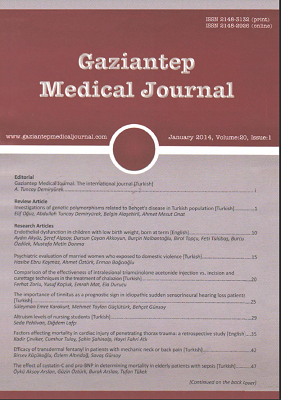Factors affecting mortality in cardiac injury of penetrating thorax trauma: a retrospective study
Kardiyak ve büyük damar hasarlanması olan penetran toraks travması hastalarındaki mortaliteye etki eden faktörler: bir retrospektif çalışma
DOI:
https://doi.org/10.5455/GMJ-30-44548Keywords:
Cardiac wounds, penetrating cardiac injuries, penetrating chest woundsAbstract
In this study, we investigated the factors affecting survival in patients who were operated for penetrating cardiac and vascular injuries due to penetrating thoracic trauma. Ninety-six patients with penetrating thoracic trauma (90 males, 6 females, mean age 26±8 years) who were admitted to our clinic between January 2010 and January 2013 were recruited to the study. Retrospective evaluation of the cause of trauma, age, gender, concomitant organ injuries, Rohman classification, Glasgow coma score, Heart Injury Scale, Lung Injury Scale, penetrating thoracic trauma index, surgical intervention, and mortality were determined. The mortality rate was 39.6% in our study and correlated with cardiac tamponade, systolic blood pressure, heart rate, Glasgow coma score, heart injury scale and penetrating thoracic trauma index. However, a significant relationship was found only between mortality and systolic blood pressure in a binary logistic regression model (p=0.024). In patients with penetrating thoracic trauma, rapid assessment and management of fluid and blood resuscitation that can hold the systolic blood pressure above 80 mmHg and prompt surgical intervention may reduce mortality and may affect the outcomes in penetrating cardiac and other major vascular injuries.
Metrics
References
Asensio JA, Petrone P, Karşıdağ T, Ramos-Kelly JR, Demiray S, Roldan G, et al. Penetrating cardiac injuries. Complex injuries and difficult challenges. Ulusal Travma Dergisi 2003;9(1):1-16.
Harris DG, Papagiannopoulos KA, Pretorius J, Van Rooyen T, Rossouw GJ. Current evaluation of cardiac stab wounds. Ann Thorac Surg 1999;68(6):2119-22.
Patel AN, Brennig C, Cotner J, Lovitt MA, Foreman ML,Wood RE, et al. Successful diagnosis of penetrating cardiac injury using surgeon-performed sonography. Ann Thorac Surg 2003;76(6):2043-6.
Attar S, Suter CM, Hankins JR, Sequeira A, McLaughlin JS. Penetrating cardiac injuries. Ann Thorac Surg 1991;51(5):711-5.
Ivatury RR, Nallathambi MN, Rohman M, Stahl WM. Penetrating cardiac trauma. Quantifying the severity of anatomic and physiologic injury. Ann Surg 1987;205(1):61- 6.
Baskett PJ. ABC of major trauma. Management of hypovolaemic shock. BMJ 1990;300(6737):1453-7.
Asensio JA, Murray J, Demetriades D, Berne J, Cornwell E, Velmahos G, et al. Penetrating cardiac injuries: a prospective study of variables predicting outcomes. J Am Coll Surg 1998;186(1):24-34.
Campbell NC, Thomson SR, Muckart DJ, Meumann CM, Van Middelkoop I, Botha JB. Review of 1198 cases of penetrating cardiac trauma. Br J Surg 1997;84(12):1737-40.
Moreno C, Moore EE, Majure JA, Hopeman AR. Pericardial tamponade: a critical determinant for survival following penetrating cardiac wounds. J Trauma 1986;26(9):821-5.
Tyburski JG, Astra L, Wilson RF, Dente C, Steffes C. Factors affecting prognosis with penetrating wounds of the heart. J Trauma 2000;48(4):587-90.
Thourani VH, Feliciano DV, Cooper WA, Brady KM, Adams AB, Rozycki GS, et al. Penetrating cardiac trauma at an urban trauma center: a 22-year perspective. Am Surg 1999;65(9):811-6.
Buchman TG, Phillips J, Menker JB. Recognition, resuscitation and management of patients with penetrating cardiac injuries. Surg Gynecol Obstet 1992;174(3):205-10.
Yavuz C, Cil H, Basyigit I, Demirtas S, Islamoglu Y, Tekbas G, et al. Factors affecting mortality in penetrating cardiac injuries: our 10-year results. Türk Göğüs Kalp Damar Cer Derg 2011;19(3):337-43.
Tokat AO, Karasu S. Penetran Toraks Travmaları. In: Yücel O, ed. Toraks Travmaları ve Tedavisi, Ankara, Derman Tıbbi Yayıncılık, 2013;22-9.
Altunkaya A, Aktunç E, Kutluk AC, Büyükateş M, Demircan N, Demir AS, et al. Analysis of 282 patients with thoracic trauma. Türk Göğüs Kalp Damar Cer Derg 2007;15(2):127- 32.
Navsaria PH, Nicol AJ. Haemopericardium in stable patients after penetrating injury: is subxiphoid pericardial window and drainage enough? A prospective study. Injury 2005;36(6):745-50.
Aksöyek A, Tütün U, Babaroglu S, Parlar AI, Ulus AT, Katırcıoglu SF. Penetrating cardiac injuries. Ulus Travma Acil Cerrahi Derg 2007;13(2):135-41.
Demirci Ş, Günaydın İG, Arıbaş OK. Deaths due to penetrating chest injury. Genel Tıp Derg. 2000;10 (2):63-9.
Başoğlu A, Akdağ AO, Çelik B, Demircan S. Thoracic trauma: An analysis of 521 patients. Ulusal Travma Derg 2004;10(1):42-6.
Alanezi K, Milencoff GS, Baillie FG, Lamy A, Urschel JD. Outcome of major cardiac injuries at a Canadian trauma center. BMC Surg 2002;2:4.
Mandal AK, Oparah SS. Unusually low mortality of penetrating wounds of the chest. Twelve years' experience. J Thorac Cardiovasc Surg 1989;97(1):119-25.
Downloads
Published
How to Cite
Issue
Section
License
Copyright (c) 2023 European Journal of Therapeutics

This work is licensed under a Creative Commons Attribution-NonCommercial 4.0 International License.
The content of this journal is licensed under a Creative Commons Attribution-NonCommercial 4.0 International License.


















